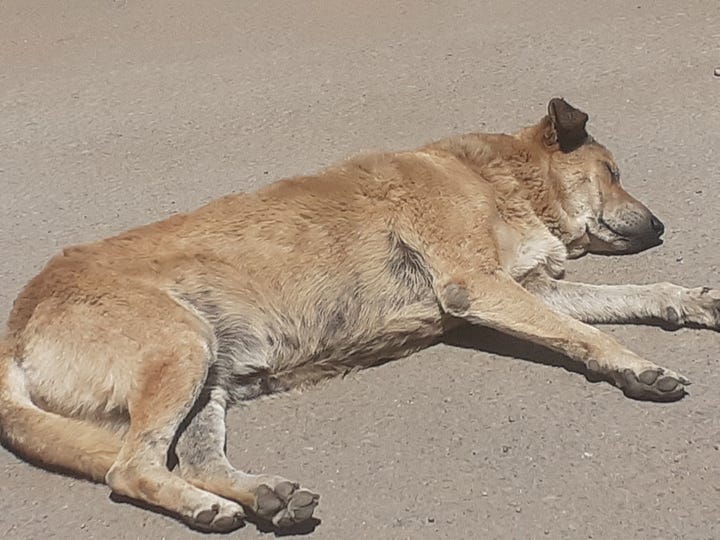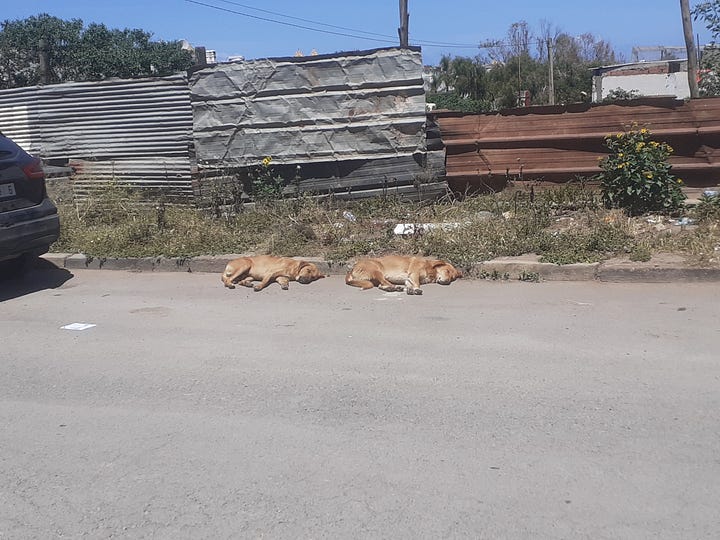The Culling of the Dogs: Morocco's plan to kill 3 million dogs is long overdue
Life in the peaceable Cherifian Kingdom
It was like yesterday.
I jumped out of a taxi to witness 30 to 40 vicious dogs fighting on the street. In their midst was a man carrying a bloodied dog out of the pack.
As he approached me, I mentioned to him that we’ve got to kill these dogs. I said it’s getting ridiculous.
“Kill yourself,” he screamed in French. “Dogs aren’t the problem, it’s humans like you.”
He had more unkind words for me, but I kept my cool. I’ve learned not to engage in the streets with emotional Moroccans. As I walked away, I was reminded of the first full proverb I learned in Arabic: الكلب وصاحبه كلبان . A dog and his keeper are two dogs.
Now, I am not a dog hater. In fact, I would love to have a Rhodesian Ridgeback, my favorite dog. But after living in Dar Bouazza for two years, I am tired of being attacked by stray dogs on the beach or while riding a bike. I no longer want to step over dogs to enter restaurants or supermarkets. Dogs run in packs, fight in the streets, push over garbage cans, spread rabies and mange, and bite innocent children.
All night long, you can hear hundreds of howling dogs in any city or town in this otherwise peaceful kingdom. They are much louder than the call for prayer at Fajr but no one seems to complain. Moi. J’en ai marre. I am fed up.
That’s why I am so elated to hear that the Moroccan government is reducing the feral dog population by 3 million before 2030. Culling is the process of selective slaughter of feral animals. Culling sounds much more humane than killing. But that is what it is. They are killed with poison, guns and traps. It is not an ideal nor kind remedy but the proliferation of stray dogs is a scourge and shame upon Morocco.
Recent news reports claim that the new initiative to kill wild dogs is in preparation for the 2030 FIFA World Cup where Morocco will share hosting the event with Spain and Portugal. But I believe the culling process began many years ago.
I remember reading about a 44-year-old French woman visiting El Argoub, a seaside resort known for kitesurfing near Dakhla in August 2022. It was her first day in Morocco and she went out for a walk and a pack of dogs attacked her. Officials found her body half eaten. It created a quick reaction. Months later, I was Azrou, in the Atlas mountains, when my mechanic told me “hunters” (they were actually government workers) came and stuck a stray dog with a long needle. Within two minutes, he said, the dog was dead and the eight puppies under an abandoned car, still blind, would soon die from starvation. So sad. But who will raise and feed them?




Of course, animal rights activists are angered by what they call a “horrific” and “brutal” killing process. Even conservationist Dr. Jane Goodall (when I was kid she was kissing wild chimpanzees in the jungles of Africa) expressed concern about Morocco’s decision. Goodall, still beautiful and vibrant at 90, is an icon among animal rights activists who see culling as a heartless and bloody quick fix. Instead they advocate for adoption or sterilization.
I see their point. But the fact is that many Moroccan households cannot afford to maintain a dog let alone bring the animal to the vet every year. In this economy, some families must delay bring their own children to the doctor or buying drugs at the pharmacy. Raising dogs is expensive and almost a full-time project. Just like everywhere, kids want a puppy to play with, but as soon as they get home, they get discracted and forget the dog. Who feeds and walks the dog?
A clash of cultures
The Islamic and Arab world have come a long way in their relationship with what Westerners call “man’s best friend.” It seems that people always kept birds in their homes; but I wonder, when did dogs become pets?
I read that shortly after the conquest of Mecca, the Prophet Muhammad (SAWS) ordered his troops to kill all the stray dogs. They killed and killed until the locals started to complain. Then it was made permissible to have a dog but only for work or hunting.
A local and longtime resident of Dar Bouazza once told me that decades ago, the local men got together annually and killed the dogs to reduce their numbers. I am sure I could find evidence that Morocco has a history of culling dogs in Morocco but the practice has stopped because of pressure from animal rights activists and Western attitudes towards dogs in particular.
It is written that it is forbidden for a Muslim to enter a house in which a dog resides. But I have read that Moroccans, who follow the Maliki methab (one of four), are more liberal about living with dogs.
Yet, most Moroccans are not at all comfortable with dogs. They shy from them, shew them away and sometimes scream in fear. Dogs are unclean. If it licks you, it takes your ablution for prayer and you have to wash seven times with sand and water. So it is believed.
It is bizzare to see a woman in complete black niqab (face covered only eyes showing) walking her pet dog in the local park. But now a younger generation, influenced by the internet, find it normal to play with a dog and let it lick their faces.
Moroccans, who keep dogs, love their pets. The dog industry is huge and you can find dog food and supply stores everywhere.
I attended a Rottweiler dog show a few years ago in Casablanca. A judge flew in from Romania and hundreds of Rottweiler enthusiasts presented their purebred yet sometimes uncontrollable registered show dogs. Local dog food companies sponsored the event.
Puppy farms are making big business as well. You can find Moroccans holding up dogs for sale in the streets. All of them are purebreds. But these illegal operations are adding to the wild dog population as some familes realize that dogs require care and the dog is left to fend for itself. Along with the culling, maybe the government could close all the puppy farms.
Quality of life
Over the past decade I have seen Morocco emerge as a modern developing nation. I remember driving on the treacherous roads to Zagora which are now modernized, efficient and safer. I remember my first high-speed train ride on the Boraq to Tanger. Hell, there is not one high-speed train in all of America!
I have seen more malls, universities, highways, libraries and apartment buildings rise to create a better quality of life for Moroccans and the millions of tourists who visit every year.
The wild dogs, who threaten the quality of life for humans, are a clear and present problem. Culling their numbers is necessary, timely and evidence that the government places human rights first and foremost. If not, Morocco can be like India which leads the world with 62 million feral dogs and the largest number of rabies deaths.
You may not agree with my sentiments, but I hope you enjoyed reading my opinion.
I tried to publish this opinion piece in a Moroccan newspaper but it was rejected because it could not be confirmed that the culling is an official and current Moroccan government policy. Somethings go unsaid in the peaceable Cherifian Kingdom.
K. Barrett Bilali is an independent journalist and founder of The AngloMedia Group, an English-based communications and public relations firm with offices in Rabat and Casablanca.





An excellent and honest assessment!